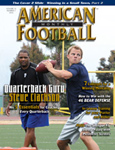AMERICAN FOOTBALL MONTHLY THE #1 RESOURCE FOR FOOTBALL COACHES
Article CategoriesAFM Magazine
|
Offensive and Defensive Collision Drills To Improve Your Teamís Performanceby: Walter JusticeFormer College and European Club Coach © More from this issue Little boys and men play football because it helps release aggressive energy and humbles all who have tried it. The sensation of running into someone at full speed is defining. No other element of football accelerates players, coaches and spectators than hearing the impact of a collision. Shoulder pads, helmets, forearms, and brute force contacting each other with speed and leverage. I began being a good football coach when I taught players how to take on a full contact collision. Every practice, video session, and meeting the biomechanics of contact must be emphasized. The key is to deliver and not absorb the shock of the collision. I strongly believe that having players perform full contact drills should be limited in practice and drills. The key is to allow the player to practice techniques, positioning, and leverage of cont....The full article can only be seen by subscribers. Subscribe today!
|
|
|||||||
| HOME |
MAGAZINE |
SUBSCRIBE | ONLINE COLUMNISTS | COACHING VIDEOS |
Copyright 2025, AmericanFootballMonthly.com
All Rights Reserved





